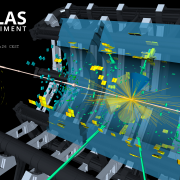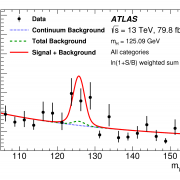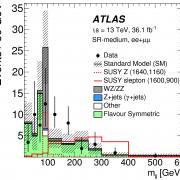Access to Collaboration Site and Physics Results

The discovery of a Higgs Boson in 2012 by the ATLAS and CMS experiments marked a key milestone in the history of particle physics. It confirmed a long-standing prediction of the Standard Model, the theory that underlines our present understanding of elementary particles and their interactions.
The Standard Model makes accurate predictions for the strength of the interactions (or “couplings“) of the Higgs boson with other particles. The most famous of these predictions is that the Higgs boson couples to matter particles (fermions) with a strength proportional to the particle’s mass, and to force particles (bosons) with a strength proportional to the square of the particle’s mass. This, and other predictions can be experimentally tested.
It can be tricky to measure the Higgs boson’s individual couplings, as each observed Higgs boson event comes with a certain production mode (e.g. gluon gluon fusion, gg->H), and Higgs decay mode (e.g. Higgs to two photons, (H->gg), each of these having their own couplings to the Higgs.
The Standard Model makes accurate predictions for the strength of the interactions (or “couplings“) of the Higgs boson with other particles. The most famous of these predictions is that the Higgs boson couples to matter particles (fermions) with a strength proportional to the particle’s mass, and to force particles (bosons) with a strength proportional to the square of the particle’s mass.
A value we can measure precisely is the cross-section (σ) of a full process, such as any production process giving H->gg, as this is measured simply by counting how many times these processes occur in proton–proton collisions, with respect to the total number of collisions recorded by the ATLAS detector.

Looking at additional particles (such as jets initiated by quarks, or Z or W bosons) produced in association with the Higgs boson provides information about the production mechanism. These cross-sections can be expressed as products of factors (kj) of the coupling strengths for Higgs production and decay, where j can represent the different particles the Higgs couples to (e.g. kb). Each kj parameterizes the ratio of the coupling strength j to that predicted by the Standard Model, so that kj =1 corresponds to the Standard Model case.
The combined analysis of all observed Higgs production and decay modes allows one to disentangle to a certain extent the production and decay strengths, and to access the coupling strengths of the Higgs boson to each of several particles, as measured by the kj factors. Figure 1 shows the results of the ATLAS analysis, showing that the couplings of the Higgs to different particles are indeed proportional to the mass (or mass-squared) of the particle. The results match Standard Model expectations.
The analysis also allows tests for more radical deviations from the Standard Model. For example, limits are set on anomalous couplings of the Higgs boson, which would be due to unknown particles contributing through quantum effects, and Higgs boson decays to invisible or undetected particles, a process not allowed in the Standard Model.
Figure 2 shows the signal strengths, µ, of the different processes, which are calculated as the measured cross-section (σ), divided by the predicted cross-section of the Standard Model (σSM). When µ = σ / σSM = 1 (within the uncertainty of the measurement), this tell us that our measured cross-section is as the Standard Model predicts, verifying the theory. A new combination of all the production modes and decay channels gives the most precise value of the signal strength to date, of µ = 1.18 +0.15 – 0.14.








